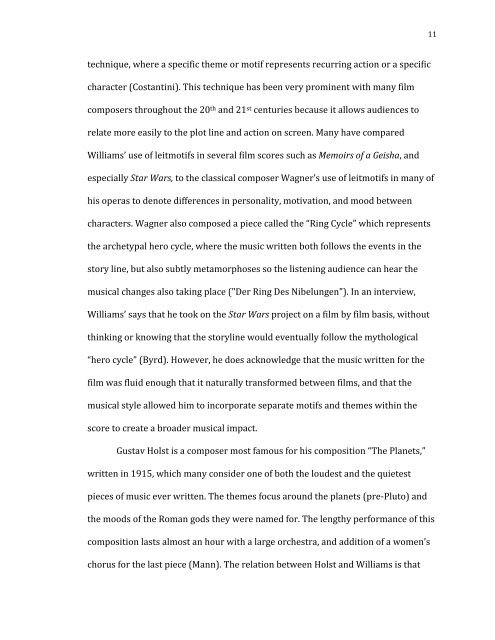Final Thesis - John Williams - ScholarsArchive at Oregon State ...
Final Thesis - John Williams - ScholarsArchive at Oregon State ...
Final Thesis - John Williams - ScholarsArchive at Oregon State ...
Create successful ePaper yourself
Turn your PDF publications into a flip-book with our unique Google optimized e-Paper software.
technique, where a specific theme or motif represents recurring action or a specific<br />
character (Costantini). This technique has been very prominent with many film<br />
composers throughout the 20 th and 21 st centuries because it allows audiences to<br />
rel<strong>at</strong>e more easily to the plot line and action on screen. Many have compared<br />
<strong>Williams</strong>’ use of leitmotifs in several film scores such as Memoirs of a Geisha, and<br />
especially Star Wars, to the classical composer Wagner’s use of leitmotifs in many of<br />
his operas to denote differences in personality, motiv<strong>at</strong>ion, and mood between<br />
characters. Wagner also composed a piece called the “Ring Cycle” which represents<br />
the archetypal hero cycle, where the music written both follows the events in the<br />
story line, but also subtly metamorphoses so the listening audience can hear the<br />
musical changes also taking place ("Der Ring Des Nibelungen"). In an interview,<br />
<strong>Williams</strong>’ says th<strong>at</strong> he took on the Star Wars project on a film by film basis, without<br />
thinking or knowing th<strong>at</strong> the storyline would eventually follow the mythological<br />
“hero cycle” (Byrd). However, he does acknowledge th<strong>at</strong> the music written for the<br />
film was fluid enough th<strong>at</strong> it n<strong>at</strong>urally transformed between films, and th<strong>at</strong> the<br />
musical style allowed him to incorpor<strong>at</strong>e separ<strong>at</strong>e motifs and themes within the<br />
score to cre<strong>at</strong>e a broader musical impact.<br />
Gustav Holst is a composer most famous for his composition “The Planets,”<br />
written in 1915, which many consider one of both the loudest and the quietest<br />
pieces of music ever written. The themes focus around the planets (pre-Pluto) and<br />
the moods of the Roman gods they were named for. The lengthy performance of this<br />
composition lasts almost an hour with a large orchestra, and addition of a women’s<br />
chorus for the last piece (Mann). The rel<strong>at</strong>ion between Holst and <strong>Williams</strong> is th<strong>at</strong><br />
11















